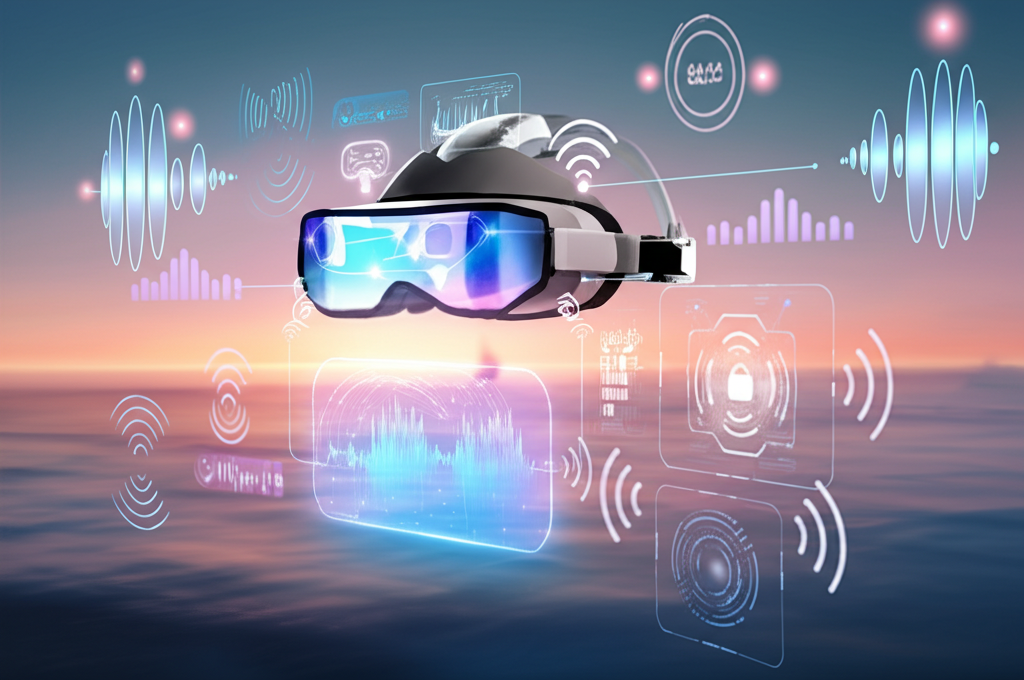As UX designers, we've long focused on what users can see and touch. Visuals, haptics, and interactions on a flat screen have shaped the foundation of modern digital experiences. But the future? It's beyond that screen.
Immersive technology — AR, VR, spatial computing — is not only adding layers to our designs; it's shifting how humans perceive and interact with the digital world. We are moving into an age where multi-sensory design isn't just a luxury; it's the new UX frontier. This article explores the science, psychology, and practical strategies behind designing for a multi-sensory experience that transcends traditional screens.
Understanding Multi-Sensory UX: A New Paradigm
In the physical world, we engage with our environment through multiple senses — sight, sound, touch, smell, and even taste. The idea behind multi-sensory UX is to replicate this natural interaction within digital environments, creating richer, more immersive experiences.
Emerging technologies like Apple Vision Pro, Meta's Quest, and haptic suits are already making waves. These systems stimulate multiple senses at once, creating digital environments that feel tangible. The future of UX design is no longer about flat surfaces — it's about space, sound, and sensation working together.
Why This Matters: The human brain craves multi-sensory input. According to neuroscience research, sensory convergence in the brain enhances memory retention and emotional engagement. Designing for multiple senses taps into this primal need, creating experiences that not only captivate but also stick.
Key Insight
Multi-sensory design isn't just about adding more features—it's about creating experiences that feel more human by engaging with users the way the real world does: through multiple senses simultaneously.
The Building Blocks of Multi-Sensory Design
Designing for multiple senses requires a fundamental shift in how we think about interaction design. Instead of focusing solely on visual hierarchies and touchpoints, UX designers now have to consider the interplay of:
- Spatial Awareness: How does the user physically move through space, and how can digital interfaces adapt in real-time?
- Soundscapes: How does sound guide the user through an experience? Does it enhance or distract? Imagine subtle audio cues guiding users through an app or AR interface.
- Haptic Feedback: How do tactile sensations translate into emotions? When users press a button in VR, should it feel soft, resistant, or metallic?
- Olfactory Design: Though still in its infancy, scent-based interfaces are being explored, particularly in therapeutic, immersive environments. Smell can evoke powerful memories and emotions, amplifying the user's connection to a digital experience.
This multi-modal approach opens endless possibilities. For example, in a virtual retail store, users can feel the texture of clothes through haptic gloves, hear ambient music, and even smell the fragrance of a new perfume line — all from the comfort of their home.
Case Study: Apple Vision Pro & Spatial Computing
The Apple Vision Pro is a perfect example of how multi-sensory design is revolutionizing the UX field. This AR headset pushes the boundaries of spatial computing by creating a fully immersive experience that combines sight, sound, and touch.
What makes Apple Vision Pro special isn't just its AR capabilities — it's how seamlessly it integrates multiple senses into one cohesive experience. The device tracks users' eye movements, detecting where they're looking, while subtle haptics provide feedback when they interact with virtual objects. The sound is spatially aware, meaning it feels as though it's coming from the direction of the object you're interacting with.
The result? Users don't just see the interface — they feel inside it. It's an experience that mimics real-world interaction while leveraging the best aspects of the digital world.
The Science of Sensory Perception: Why Multi-Sensory Experiences Work
The human brain processes multi-sensory information faster and more effectively than single-sense stimuli. When multiple senses are activated simultaneously, they create a more powerful and memorable experience. This is known as sensory integration.
Consider how we interact in the physical world. When you enter a cafe, you don't just see the environment. You hear the background chatter, smell the fresh coffee, and feel the warmth of your cup. Each sense enhances the other, creating a rich, immersive experience that your brain processes as a whole. Digital environments should aim to replicate this complexity.
Neuromarketing research reveals that multi-sensory design can increase user engagement and emotional response by up to 70%. The more senses you involve in your UX, the deeper the emotional connection with the user.
Designing for the Future: Practical Strategies for Multi-Sensory UX
So, how can we, as UX designers, start to integrate multi-sensory elements into our digital experiences?
a. Start with Storytelling
Every great multi-sensory experience starts with a story. What journey are you taking the user on? Define how each sense can contribute to that narrative. Think of it like film directing: visuals, sound, and touch all work together to create an emotional arc for the user.
b. Create Sensory Feedback Loops
Design interactions that provide feedback through multiple senses. For example, when a user clicks a button in VR, they don't just see the action — they feel it through haptics and hear a confirming sound.
c. Use Sound Thoughtfully
Designers often overlook sound, but it's a powerful tool. Consider creating dynamic soundscapes that change based on user interaction, location, or emotion. Sound should guide the user, not overwhelm them.
d. Prioritize Accessibility
One challenge of multi-sensory design is ensuring it's inclusive. Some users may have impairments in one or more senses, so it's critical to provide alternative ways to interact with the interface. For example, users who can't hear should receive additional haptic or visual feedback to ensure they're not excluded from the experience.
e. Experiment with Emerging Technologies
Get hands-on with technologies like AR glasses, VR headsets, haptic suits, and even scent-enabled devices. By staying on the cutting edge of what's possible, you'll gain a competitive advantage in the multi-sensory UX space.
What Lies Ahead: The Next Frontier in UX
As multi-sensory UX evolves, we'll see digital experiences that are indistinguishable from real-life interactions. Full-sensory immersion will become the gold standard for entertainment, e-commerce, healthcare, and education. The key to success is thinking beyond sight and touch, exploring how to engage users through sound, motion, temperature, and even smell.
For UX designers, this shift represents an unprecedented opportunity to push boundaries and pioneer new forms of interaction. Those who embrace this movement early will be at the forefront of the multi-sensory revolution.
Conclusion: A Call to Innovate
As the digital landscape transforms into a multi-sensory playground, UX designers must think beyond the screen. The future of interaction lies in the integration of all human senses — creating interfaces that don't just look good but feel, sound, and even smell like real-world experiences. Designing for this future means opening up new worlds of emotional engagement, memory retention, and immersive interaction.
The future of UX is already here — are you ready to shape it?
References
- Gallace, A., & Spence, C. (2014). In touch with the future: The sense of touch from cognitive neuroscience to virtual reality. Oxford University Press.
- Obrist, M., Velasco, C., Vi, C., Ranasinghe, N., Israr, A., Cheok, A., & Gopalakrishnakone, P. (2016). Touch, taste, & smell user interfaces: The future of multisensory HCI. In Proceedings of the 2016 CHI Conference Extended Abstracts on Human Factors in Computing Systems.
- Spence, C., & Gallace, A. (2011). Multisensory design: Reaching out to touch the consumer. Psychology & Marketing, 28(3), 267-308.
- Maggioni, E., Cobden, R., Dmitrenko, D., & Obrist, M. (2020). Smell-O-Message: Integration of olfactory notifications into a messaging application to improve users' performance. In Proceedings of the 2020 CHI Conference on Human Factors in Computing Systems.
- Obrist, M., Gatti, E., Maggioni, E., Vi, C. T., & Velasco, C. (2017). Multisensory experiences in HCI. IEEE MultiMedia, 24(2), 9-13.

Khwahish Kushwah
UX Designer & Prompt Engineer
Passionate about creating intuitive digital experiences that blend psychology, design principles, and cutting-edge AI technologies. I write about UX design, AI interfaces, and the future of digital experiences.
